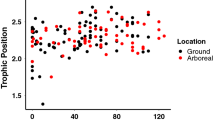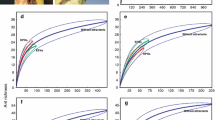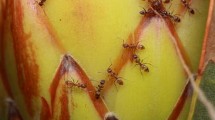Abstract
Animals frequently experience resource imbalances in nature. For ants, one resource that may be particularly valuable for both introduced and native species is high-carbohydrate honeydew from hemipteran mutualists. We conducted field and laboratory experiments: (1) to test if red imported fire ants (Solenopsis invicta) competed with native ants for access to mutualisms with aphids, and (2) to quantify the effects of aphid honeydew presence or absence on colony growth of native ants. We focused on native dolichoderine ants (Formicidae, Dolichoderinae) because they are abundant ants that have omnivorous diets that frequently include mutualist-provided carbohydrates. At two sites in the southeastern US, native dolichoderine ants were far less frequent, and fire ants more frequent, at carbohydrate baits than would be expected based on their frequency in pitfall traps. A field experiment confirmed that a native ant species, Dorymyrmex bureni, was only found tending aphids when populations of S. invicta were suppressed. In the laboratory, colonies of native dolichoderine ants with access to both honeydew and insect prey had twice as many workers and over twice as much brood compared to colonies fed only ad libitum insect prey. Our results provide the first experimental evidence that introduced ants compete for access to mutualist-provided carbohydrates with native ants and that these carbohydrates represent critical resources for both introduced and native ants. These results challenge traditional paradigms of arthropod and ant nutrition and contribute to growing evidence of the importance of nutrition in mediating ecological interactions.



Similar content being viewed by others
References
Andersen AN (1997) Functional groups and patterns of organization in North American ant communities: a comparison with Australia. J Biogeogr 24:433–460
Beggs J (2001) The ecological consequences of social wasps (Vespula spp.) invading an ecosystem that has abundant carbohydrate resource. Biol Conserv 99:17–28
Blüthgen N, Gebauer G, Fiedler K (2003) Disentangling a rainforest food web using stable isotopes: dietary diversity in a species-rich ant community. Oecologia 137:426–435
Calixto AA, Harris MK, Knutson A, Barr CL (2007a) Native ant responses to Solenopsis invicta buren reduction using broadcast baits. Environ Entomol 36:1112–1123
Calixto AA, Harris MK, Barr C (2007b) Resurgence and persistence of Dorymyrmex flavus after reduction of Solenopsis invcta buren with a broadcast bait. Environ Entomol 36:549–554
Cook SC, Eubanks MD, Gold RE, Behmer ST (2010) Colony-level macronutrient regulation in ants: mechanisms, hoarding and associated costs. Anim Behav 79:429–437
Davidson DW (1997) The role of resource imbalances in the evolutionary ecology of tropical arboreal ants. Biol J Linn Soc 61:153–181
Davidson DW, Cook SC, Snelling RR, Chua TH (2003) Explaining the abundance of ants in lowland tropical rainforest canopies. Science 300:969–972
Dussutour A, Simpson SJ (2008) Carbohydrate regulation in relation to colony growth in ants. J Exp Biol 211:2224–2232
Dussutour A, Simpson SJ (2009) Communal nutrition in ants. Curr Biol 19:1–5
Dussutour A, Simpson SJ (2012) Ant workers die young and colonies collapse when fed a high-protein diet. Proc R Soc Lond B 279:2402–2408
Eubanks MD (2001) Estimates of the direct and indirect effects of red imported fire ants on biological control in field crops. Biol Control 21:35–43
Fagan WF, Siemann E, Mitter C, Denno RF, Huberty AF, Woods HA, Elser JJ (2002) Nitrogen in insects: implications for trophic complexity and species diversification. Am Nat 160:784–802
Fanson BG, Yap S, Taylor PW (2012) Geometry of compensatory feeding and water consumption in Drosophila melanogaster. J Exp Biol 216:766–773
Grover CD, Kay AD, Monson JA, Marsh TC, Holway DA (2007) Linking nutrition and behavioural dominance: carbohydrate scarcity limits aggression and activity in Argentine ants. Proc Biol Sci 274:2951–2957
Hawlena D, Schmitz OJ (2010) Herbivore physiological response to predation risk and implications for ecosystem nutrient dynamics. Proc Natl Acad Sci USA 107:15503–15507
Helms KR, Vinson SB (2002) Widespread association of the invasive ant Solenopsis invicta with an invasive mealybug. Ecology 83:2425–2438
Helms KR, Vinson SB (2008) Plant resources and colony growth in an invasive ant: the importance of honeydew-producing hemiptera in carbohydrate transfer across trophic levels. Environ Entomol 37:487–493
Hölldobler B, Wilson EO (1990) The Ants. Harvard University Press, Cambridge
Holway DA, Lach L, Suarez AV, Tsutsui ND, Case TJ (2002) The causes and consequences of ant invasions. Annu Rev Ecol Syst 33:181–233
Hook AW, Porter SD (1990) Destruction of harvester ant colonies by invading fire ants in south-central Texas (Hymenoptera: Formicidae). Southwest Nat 35:477–478
Kay AD, Zumbusch TB, Heinen JL, Marsh TC, Holway DA (2010) Nutrition and interference competition have interactive effects on the behavior and performance of Argentine ants. Ecology 91:57–64
King JR, Tschinkel WR (2006) Experimental evidence that the introduced fire ant, Solenopsis invicta, does not competitively suppress co-occurring ants in a disturbed habitat. J Anim Ecol 75:1370–1378
King JR, Tschinkel WR (2008) Experimental evidence that human impacts drive fire ant invasions and ecological change. Proc Natl Acad Sci USA 105:20339–20343
Lach L, Parr CL, Abbott KL (2010) Ant ecology. Oxford University Press, Oxford
LeBrun EG, Tillberg CV, Suarez AV, Folgarait PJ, Smith CR, Holway DA (2007) An experimental study of competition between fire ants and Argentine ants in their native range. Ecology 88:63–75
LeBrun EG, Plowes RM, Gilbert LE (2012) Imported fire ants near the edge of their range: disturbance and moisture determine prevalence and impact of an invasive social insect. J Anim Ecol 81:884–895
Macom TE, Porter SD (1995) Food and energy requirements of laboratory fire ant colonies (Hymenoptera: Formicidae). Environ Entomol 24:387–391
Morrison LW (2002) Long-term impacts of an arthropod-community invasion by the imported fire ant, Solenopsis invicta. Ecology 83:2337–2345
Pontin AJ (1978) The numbers and distribution of subterranean aphids and their exploitation by the ant Lasius flavus (Fabr.). Ecol Entomol 3:203–207
Porter SD (1989) Effects of diet on the growth of laboratory fire ant colonies (Hymenoptera: Formicidae). J Kansas Entomol Soc 62:288–291
Porter SD, Savignano DA (1990) Invasion of polygyne fire ants decimates native ants and disrupts arthropod community. Ecology 71:2095–2106
Raubenheimer D, Simpson SJ, Mayntz D (2009) Nutrition, ecology and nutritional ecology: toward an integrated framework. Funct Ecol 23:4–16
Savage AM, Rudgers JA, Whitney KD (2009) Elevated dominance of extrafloral nectary-bearing plants is associated with increased abundances of an invasive ant and reduced native ant richness. Divers Distrib 15:751–761
Savage AM, Johnson SD, Whitney KD, Rudgers JA (2011) Do invasive ants respond more strongly to carbohydrate availability than co-occurring non-invasive ants? A test along an active Anoplolepis gracilipes invasion front. Aust Ecol 36:310–319
Simpson SJ, Raubenheimer D (2012) The nature of nutrition: a unifying framework from animal adaptation to human obesity. Princeton University Press, Princeton
Simpson SJ, Sibly RM, Lee KP, Behmer ST, Raubenheimer D (2004) Optimal foraging when regulating intake of multiple nutrients. Anim Behav 68:1299–1311
Slansky F, Rodriguez JG (1987) Nutritional ecology of insects, mites, spiders and related invertebrates. Wiley, New York
Stadler B, Dixon AFG (2005) Ecology and evolution of aphid-ant-interactions. Annu Rev Ecol Evol Syst 36:345–372
Sterner RW, Elser JJ (2002) Ecological stoichiometry: the biology of elements from molecules to the biosphere. Princeton University Press, Princeton
Tschinkel WR (2006) The fire ants. Belknap Press, Cambridge
Vinson SB (1983) The physiology of the imported fire ant revisited. Fla Entomol 66:126–139
Vinson SB (1994) Impact of the invasion of Solenopsis invicta Buren on native food webs. In: Williams DF (ed) Exotic ants: biology, impact and control of introduced species. Westview Press, Boulder, Colorado, pp 240–258
Wäckers F, van Rijn PCJ, Bruin J (2005) Plant-provided food for carnivorous insects: a protective mutualism and its applications. Cambridge University Press, Cambridge
Way MJ (1963) Mutualism between ants and honeydew-producing homoptera. Annu Rev Entomol 8:307–344
Wilder SM, Eubanks MD (2010) Might nitrogen limitation promote omnivory among carnivorous arthropods? Comment. Ecology 91:3114–3117
Wilder SM, Holway DA, Suarez AV, LeBrun EG, Eubanks MD (2011a) Intercontinental differences in resource use reveal the importance of mutualisms in fire ant invasions. Proc Natl Acad Sci USA 108:20639–20644
Wilder SM, Holway DA, Suarez AV, Eubanks MD (2011b) Macronutrient content of plant-based food affects growth of a carnivorous arthropod. Ecology 92:325–332
Acknowledgments
Funding was provided by National Science Foundation DEB 0716983 to M.D.E., DEB 0717054 to D.A.H. and DEB 0716966 to A.V.S. We thank M. Buckman for field assistance in Alabama and Michael Castro for assistance with laboratory work. We thank B. Stadler and two anonymous reviewers for helpful comments on a previous draft of this manuscript. All experiments complied with current US laws.
Conflict of interest
The authors declare that they have no conflict of interest.
Author information
Authors and Affiliations
Corresponding author
Additional information
Communicated by Bernhard Stadler.
Electronic supplementary material
Below is the link to the electronic supplementary material.
Rights and permissions
About this article
Cite this article
Wilder, S.M., Barnum, T.R., Holway, D.A. et al. Introduced fire ants can exclude native ants from critical mutualist-provided resources. Oecologia 172, 197–205 (2013). https://doi.org/10.1007/s00442-012-2477-7
Received:
Accepted:
Published:
Issue Date:
DOI: https://doi.org/10.1007/s00442-012-2477-7




